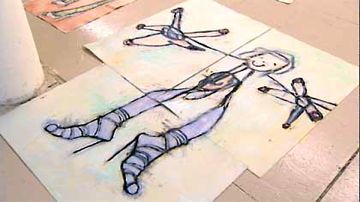As promised in last week’s column I want to share some possibilities when it comes to facilitating in-progress critiques with students. Critiques that take place as an idea is taking shape vs. when a work is finished can produce wonderful results, especially with classes that learn to look critically and offer manageable suggestions. Here are three options I’ve tried:
The “Easel” Critique
Instead of students putting up all works at once, the teacher asks students to put works in progress on an easel one at a time. As each is shown, class members make suggestions to add to the work or improve it. A time limit helps in two ways- it sets up a situation where students must talk about the work for a given amount of time and it allows for all students to have their work shared. For example, if there are 20 students in the group and the class is 45 minutes, each student can get two full minutes of suggestions that they jot down in a sketchbook as the discussion takes place (and you’d be amazed at how many suggestions a class can generate in two minutes once they get going). This kind of in-progress critique is especially helpful with groups that are comfortable talking with one another and with assignments where everyone is familiar with the parameters and theme.
The “Big Question” Critique
Each student in the class takes a turn sharing what their work is about and where they are in the process of creating it. Then, before moving on to the next person, the artist gets to ask the group one big question that the everyone gives specific feedback on. This kind of in-progress critique can be done in small groups to maximize the use of time. For example, a class of 30 can break into five groups of six and each student gets the chance to ask their big question to five others in order to get ideas and possibilities for next steps. Each artist takes down notes from responses to the big question and at the end of the class shares the top three responses they received with the teacher- either verbally or written.
The “Big Question” Partner Critique
Similar to the suggestion above, each student in the class shares what their work is about and where they are in the process of creating it. Only this time students pair up and discuss the work with a partner instead of a group. After each person has had a chance to share what the work is about and where they’re at, the partner then comes up with a big question for the artist that is written down in the center of a sheet of paper. Both students then brainstorm possible responses to the question and make notes using a graphic organizer of their choice. After one student has multiple answers to the big question, the process is repeated for the other partner. This allows partners to focus their classmates on issues they may not be considering or next steps that can be explored. All graphic organizers are then posted for the teacher to add feedback before the next class.
Have ideas you’ve tried? Please share them! Willing to give one of these ideas a try? Please comment on the results or send along further questions. Enjoy!




